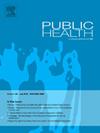Violence reduction, revisiting a public health approach
IF 3.2
3区 医学
Q1 PUBLIC, ENVIRONMENTAL & OCCUPATIONAL HEALTH
引用次数: 0
Abstract
Objectives
Propose and test an alternative method for identifying population targets for public health model derived violence reduction programmes.
Study design
Quantitative and qualitative focused on neighbourhoods in the 75th percentile of violence or higher, using Lower Super Output Areas (LSOAs) as the data collection/integration focus.
Methods
Cluster analysis to group similar LSOAs together. Significant factors in the regression analysis plus violence rates were entered into a k-means cluster analysis creating five groupings and a short list to include in the quantitative and qualitative arms.
Results
Local Government Area (LGA) or a city-wide perspective, masks locations with high violence rates and misses potential solutions. Crime and violence are more prevalent in areas with high deprivation, poor design of housing and space associated with isolation and fear. Less considered violence vectors were identified.
Conclusions
Deprivation was the strongest predictor of violence, but there are highly deprived areas that do not have high levels of violence and conversely high-violence neighbourhoods in non-deprived areas. A granular and dynamic understanding of these patterns should form the basis of future investment and intervention efforts.
减少暴力,重新审视公共卫生方针
目的提出并测试一种替代方法,用于确定公共卫生模型衍生的减少暴力方案的人口目标。研究设计:定量和定性研究集中在暴力事件发生的第75百分位数或更高的社区,使用低超级输出区(LSOAs)作为数据收集/整合重点。方法采用聚类分析方法对相似的lsoa进行分组。回归分析中的重要因素加上暴力率被纳入k均值聚类分析,创建了五组和一个简短的列表,包括在定量和定性方面。结果地方政府区域(LGA)或整个城市的视角掩盖了暴力发生率高的地区,并错过了潜在的解决方案。在贫困程度高、住房和空间设计差、与孤立和恐惧有关的地区,犯罪和暴力更为普遍。确定了较少考虑的暴力媒介。贫困是暴力的最强预测因子,但在高度贫困的地区,暴力水平并不高,相反,在非贫困地区,暴力水平也很高。对这些模式的细致和动态的理解应该成为未来投资和干预工作的基础。
本文章由计算机程序翻译,如有差异,请以英文原文为准。
求助全文
约1分钟内获得全文
求助全文
来源期刊

Public Health
医学-公共卫生、环境卫生与职业卫生
CiteScore
7.60
自引率
0.00%
发文量
280
审稿时长
37 days
期刊介绍:
Public Health is an international, multidisciplinary peer-reviewed journal. It publishes original papers, reviews and short reports on all aspects of the science, philosophy, and practice of public health.
 求助内容:
求助内容: 应助结果提醒方式:
应助结果提醒方式:


